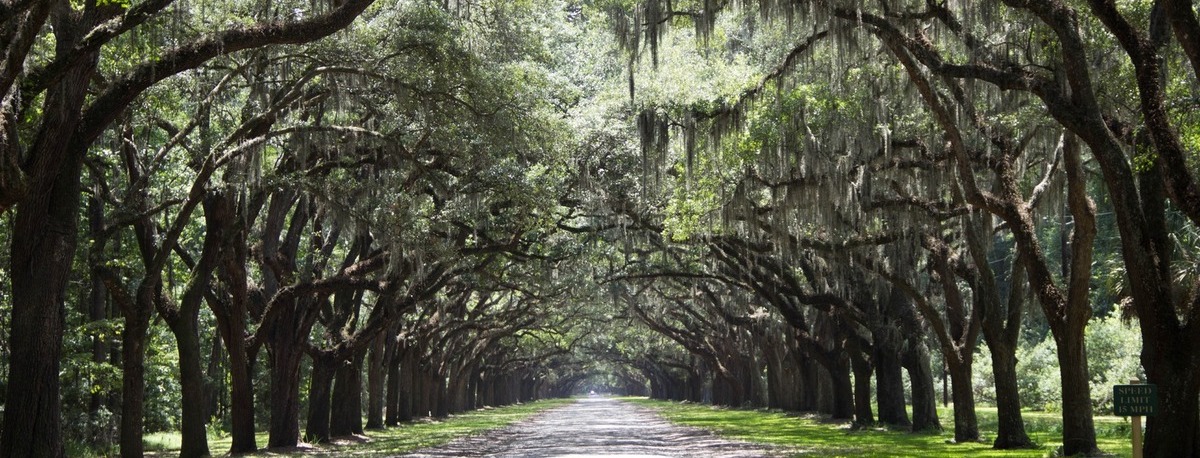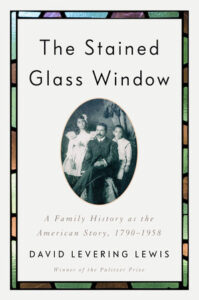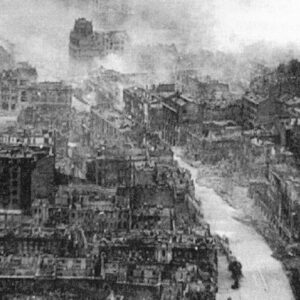
Secrets of the Deep South: In Search of Hidden Family and Collective History in Georgia
David Levering Lewis on the Eternal Questions of Race and Power Surrounding the American National Narrative
Atlanta’s tony First Congregational Church is a proud old Black church whose distinguished history half a pew of congregants hardly remembers today. Its downtown location imperils its landmarked survival, a sesquicentennial god box in a southern city famous for boasting of being “too busy to hate.” More accurately it is a city too fast for its past. Although church attendance was a long-ago-lost practice, I sat bemused that warm Sunday morning with my favorite cousin, Bettye (“kissin’ cousin,” as they used to say), in her prominent pew. My presence was remarked as unusual by the parishioners. Yet I was oddly grateful to be there, in that faux Romanesque tabernacle where fifty years ago compassionate Cousin Bettye had squeezed my hand as the minister sermonized a moving farewell over my mother’s closed coffin.
Eight months earlier I had endured my spouse’s memorial service in New York’s Riverside Church. Ruth was my anchor of thirty years. Her ovarian cancer prognosis resolved us to engage, to produce, to travel, to explore together, as if we had a lifetime remaining. In that fateful time frame, we saw Europe and Africa again, served our professional associations, produced papers and each a book; finally, I relinquished an endowed professorship at a great research university.
And now I found myself somewhat unanchored in a church on an April Sunday morning in 2015. My Atlanta visit came as a delayed subconscious reaction. Often enough, even when dismissed in the moment, the fleeting presumptuousness of white people can register deeply. Just such an unprovoked annoyance had festered with me ever since a 2014 midwestern research trip to digitally record a round of interviews for a book.
A talkative limousine chauffeur fetched me from the Indianapolis airport, volunteered a chamber of commerce inventory of local assets, commenced a genial interrogation inviting reciprocated inquiries—then, apropos nothing at all, abruptly declared that his immigrant ancestors were innocent of all discrimination against Black people. Temporarily disconcerted, I found myself unable to formulate a worthwhile thought. The chauffeur, barreling on heedless of a response, told of his people coming from Poland with no English and no relatives, poor and unskilled.
Simple folk like the chauffeur’s hardworking grandfather, whose tannery and good credit had enabled the chauffeur’s parents to own real estate, and the chauffeur, himself a retired supermarket manager, who was helping with his smart grandson’s law school tuition. Whatever had happened to Black people, not a one of his people had ever done anything against them, and he begged my acceptance of that truth. I refused the driver the satisfaction of a departing handshake, yet I strode into the hotel lobby suppressing a good deal of dissatisfaction with myself.
I asked myself why we shouldn’t conclude that what was exceptional about the exceptionalist national narrative were the historical exceptions to it.
I, a prizewinning historian, had allowed myself that midwestern morning to be run over, in a manner of speaking, by yet another unremarkable white citizen smugly piloting his color-blind American Dream across a century of self-improvement and hard-earned success. Nor had my Hoosier chauffeur’s protestations of racial innocence amounted to mere self-serving parochialism. They mirrored the prevailing judgment not only of the American mainstream but within much of the academy, ideas persuasively articulated in print and television by leading social scientists, historians, public intellectuals, and policymakers.
The belated truth, until well into my seventies, was that I myself had been intellectually intimidated by scholarship that privileged the solace of liberal reform, the pragmatism of triage, or the stoicism of dysfunction—scholarship that found empirically compelling reasons why the so-called truly disadvantaged were inescapably Black and brown people, why the intelligence bell curve diminished their progress, and why the nation was losing ground pursuing failed social experimentations. Hadn’t it become gospel that postal codes predetermining the life chances of the truly disadvantaged resulted from forces whose staggering costs of redress surpassed the available resources of the nation? That gospel, therefore, must surely excuse Caucasian chauffeurs of complicity and absolve the majority of Americans from the tragic judgment of their own history.
What I might have said to my well-meaning driver finally came to me a few weeks after my fateful decision to go to Atlanta. The old firebomb term suddenly made current in popular discourse by the truly gifted journalist Ta-Nehisi Coates—reparations—provoked a timely upheaval not so much in what I knew about what had happened in history as in my understanding of why so much that had not happened in history should have. A perfect chance to crystallize my thoughts about historical obligations in the building of the land of opportunity—about addressing what I occasionally told former students was the ethnic testosterone problem in American exceptionalism—had come my way earlier that year.
Caught surprised on an early spring morning in 2015 when an admired colleague, David Nasaw, then president of the Society of American Historians, phoned to tell me of the society’s bestowal of its Arthur M. Schlesinger Jr. Award for distinguished writing in American history, I sensed an unexpressed anxiety about an acceptance speech befitting the honor. For better or worse, I decided that by the evening of the award I would have composed something in the spirit of W.E.B. Du Bois, the great contrarian who identified the twenty-first century’s contested meanings of the color line as fundamental to the failure of our great national experiment. In the meantime, however, had come the rendezvous with my Atlanta past.
*
Although born in Arkansas and raised in the north, I had always felt the family roots were in Atlanta, where my striving Methodist father achieved early success and my independent Congregationalist mother circumspectly optimized an advantaged birthright. I had long ago resolved the inherited tensions of my parents’ contrasting backgrounds, an amalgam of Black Belt peasants mixed with free colored persons—my father’s up-from-slavery pride versus my mother’s color-spectrum privilege.
John Henry and Alice Urnestine were admired innovators in the segregated corridors of high school and college administration before Brown v. Board of Education. Yet, in a profound sense, even though their professional highs and lows remained salient, too much about their personal aspirations and struggles, as well as their forebears’ provenances, I had either never known or had gradually forgotten over the years since my mother’s death. As the last of John Henry’s five children and only son of his second wife, Alice Urnestine, I grew up virtually as an only child who gradually outlived my several geographically scattered half siblings. When I came to Atlanta with thoughts of the Schlesinger presentation gestating, John and Urnestine Lewis had lain in the city’s old South-View Cemetery for more than a half century.
Nostalgia, a historian’s intuition, and Cousin Bettye’s encouraging sense that I was onto something important, somehow ratified that Sunday morning attendance at First Congregational, the church of my mother’s people. My mother’s church had risen from Atlanta’s ashes in the winter of 1866 as a makeshift school in a converted Confederate commissary building on Jenkins Street in the heart of the city. I still remembered the story of First Congregational’s ascension from her telling, a vivid fable footnoted, as it were, from my own recent reading. As soon as it had been safe after Sherman’s departure, Yankee pastors and wives of the American Missionary Association (AMA) sped south to organize and uplift the newly freed Black people. Historian Clarence Bacote’s rich history of the church and the college they built in Atlanta’s ashes profiled these New England men and women as missionaries, just like their twentieth-century Peace Corps spiritual descendants. I recalled my mother’s frequent invocation of their motto: “To Find a Way or Make One.”
Mostly Yale men with Uncle Tom’s Cabin in their knapsacks, Wendell Phillips as their model, and strategic funding from the Freedmen’s Bureau, these Yankee missionaries followed a master plan conceived during the Confederacy’s final months by the redoubtable Erastus Milo Cravath, the AMA’s education superintendent and future founder of my undergraduate college, Fisk University. Records tell of their traveling “the length and breadth of Georgia,” visiting the larger plantations and planning with the proprietors and the emancipated an educational center in Atlanta. School sites were identified, teachers recruited, buildings bought and built, and pastors assigned with such resourcefulness that within two years the AMA men and women sowed a remarkable confessional and educational experiment in Atlanta and across the Deep South. Their labor yielded more than a half dozen HBCUs and a large crop of tabernacles variously imbued with the New England ideals of learning, citizenship, and culture.
The church’s battered commissary, enlarged and named for its Congregational benefactor, became the Storrs School, regional magnet to hundreds of learning-hungry pupils, “some sent by their families, others to come unattached,” wrote an AMA historian. “It was a strange thing to us,” recalled an everlastingly impressed student of Yale’s Edmund Asa Ware, future founder of Atlanta University, “to see a white man carrying wood and making fires for us, who had been taught…it was our duty to do the like for his kind.” The dedication of its Yankee “schoolmarms” and precocity of its charges merited a famous 1868 Storrs School inspection by the Freedmen’s Bureau chief, General Oliver Otis Howard. Indeed, my father had relished telling the story of Howard’s question to the students, “What shall I tell the children in the North about you?” A boy of twelve years replied: “Massa, tell ’em we’re rising!” That teenage boy whose remarks poet John Greenleaf Whittier made famous was Richard R. Wright, future valedictorian of Atlanta University’s 1876 first graduation.
Storrs School was the school of choice of advantaged freed people. My mother’s mother learned her letters there. Storrs cradled the future Atlanta University and First Congregational Church, Mother’s elite undergraduate college and church. And now that her church was central to my quest, I recalled the feelings of group accomplishment I felt on those infrequent Sundays when asked by my father to escort her there. First Church had become self-supporting a year after Mother was born in 1893. Henry Hugh Proctor, Fisk classmate of W.E.B. Du Bois and a Yale Divinity School graduate, assumed the pulpit as its first African American pastor.
Thirteen years later, in 1907, when Reverend Proctor broke ground for the present structure, built by the leading colored contractor Robert Pharrow, it was Booker T. Washington, honored guest of the church and the city, who shoveled the first spade of dirt. I thought the church’s extensive makeover some fifteen years ago had dialed back the sanctuary’s solemnity, muting somewhat its grand history. Even so, I easily visualized the old interior’s chiaroscuro, the unupholstered pews, the winged pulpit, but most especially those oak panels adjacent to the choir on which were inscribed the names of last century’s distinguished invitees: Booker T. Washington, Theodore Roosevelt, Presidents Taft and Coolidge, Roland Hayes, and Walter White. To be sure, parishioners assured me after the service that the processional of notables continued, as with Senator Kamala Harris’s presentation at the church’s 150th anniversary or the occasional sermons of the Honorable Andrew Young, Atlanta’s former mayor and a fellow Congregationalist.
*
As the morning’s worshippers departed, some nodding welcomes, my cousin and I waited for Reverend Dwight Andrews, Yale Divinity School’s latest gift, to walk with us to the stained glass windows in the rear of the sanctuary. When was it, some dozen years past, that I came expecting to see these windows—and one in particular, above all? They were leaded stained glass panes that prosperous church members, together with my maternal grandfather, had hired Black master craftsmen to make so as to symbolize Christianity’s four Gospels. They were twinned with illustrations of the Negro’s emancipation and rise.
The windows had been installed within two years after the new building’s 1909 dedication. The last window in the “Motherhood Triptych,” I recalled clearly, was an incandescent window depicting a Madonna and child, “dedicated to Alice K. Bell by her family.” My grandmother had been placed in the window frame next to the resplendent family homage to the Isaac Westmoreland matriarch, and that one next to the one dedicated to the mother of Reverend Henry Hugh Proctor. But my ancestor, along with the others, was not to be seen when I had stopped in transit to Hartsfield-Jackson Atlanta International Airport after an honorary doctorate award ceremony at Emory University that afternoon in May 2003.
Ruth and I, accompanied by Emory University’s ebullient Richard Long, Atticus Haygood Professor of Interdisciplinary Studies, were flabbergasted to find the sanctuary windows boarded up due to long-stalled renovations whose completion the sanguine Reverend Andrews had assured us was imminent. Now, twelve years later, I finally gazed upon them admiringly in the presence of Bettye and the beaming pastor.
Alice King Bell, my maternal grandmother, was the Madonna, deceased in childbirth at age twenty-nine in 1901. Her radiant representation in the Motherhood Triptych spoke of both premature bereavement and wistful immortality—of a prosperous colored family’s advertised devotion. Yet, despite all that meaningfulness, I realized how much the sanctuary’s Madonna and child remained unrevealed to me. All the people who could have known her were gone. Her children, my own beloved mother and empathic uncle, had died in their early seventies just as I turned thirty. John Henry Bell, Alice’s handsome husband, survived Alice by a score of years only to die tragically long before their children.
True enough, there was much that I recalled: memory echoes of the Bells’ Charleston, South Carolina, origins; of the place some miles outside Atlanta where the King dynasty reigned; of old studio photographs of my presentable grandparents and of other hazel-eyed Bells, along with their friends the Westmorelands and Whites, Ruckers and Yateses. But I thought a good deal about what I should have asked my parents, and about what they could have been pushed to reveal about their own parents’ survival as Reconstruction receded before Redemption and the one-drop rule of second-class citizenship was codified.
I recalled, too, the jolting interview response about Mother’s family given by a wizened church lady speaking of long-ago Atlanta in Du Bois’s time there: “no-nation people,” she cackled sympathetically. “They lived between the races,” she had explained to the then future Du Bois biographer. I had never heard such a term before, and certainly not to be applied to my own race-proud, middle-class family. Color gradations and their undeserved, fast-fading advantages within the African American population I had written about, perceptively, I believed, in a history of early Harlem.
Even so, the dichotomous finality of the interviewee’s description of my Bell line had been deeply unsettling. Its decreed deracination signaled a murkiness I had been unready to acknowledge until recently. Now I saw that I was being propelled by ancestral unknowns to find answers. I suspected that the woman whose born name was King, and whose dedicated sanctuary window had fascinated me from my teens, was a mystery wrapped in an antebellum conundrum of possibly outsize historical significance.
*
Roswell, Georgia, is twenty-six miles north of downtown Atlanta, an affluent town of some ninety thousand mostly white souls fixed in the aspic of the Lost Cause. A few weeks earlier, I had spent a profitable day early in this journey reading about the village named for Roswell King Sr. (1765–1844). I found that it was the old American success story of work, luck, and theft. The senior King was a legendary entrepreneur who parlayed his Windsor, Connecticut, origins into one of the South’s grandest slaveholding dynasties, an outsize life that was the bonus of impeccable timing. Cotton as North America’s future economic engine was still a gamble in the pivotal first decade of the nineteenth century. Yet he established a profitable lumber, rice, and cotton business in 1780 in tiny Darien at the mouth of Georgia’s Altamaha River.
It was a fortuitous place for King’s slave management talents to be discovered by one of the country’s largest slaveholders, Major Pierce Butler. In 1820, after eighteen handsomely rewarded years as Butler’s overseer, Roswell King Sr. arranged to be succeeded by his son Roswell Jr. (1796–1854) and resigned to become an officer in the growing Bank of Darien. His timing again paid major dividends in 1829 when, as the bank’s roaming gold prospector, he saw the Cherokee Nation’s Edenic realm of hardwood forests, rushing streams, and fertile valleys—all of it awaiting Andrew Jackson’s removal order.
Three years later, after Georgia issued its first lottery of Cherokee lands, Roswell King Sr. purchased a large tract near the Chattahoochee River and bided his time until the U.S. Army herded the tribe into encampments prior to the brutal confiscation of its lands and the western expulsion of the Cherokees in 1838. Roswell then persuaded five Georgia coastal dwellers to join him on the now confiscated up-country lands. He incorporated the Roswell Manufacturing Company the following year, its towering brick cotton mill powered by Vickery Creek, a Chattahoochee tributary. Seven years later, the mill factory added 3,500 spindles and 400 looms manned by 150 white laborers, its cotton, yarn, cloth, and rope products sold in Baltimore, Philadelphia, and Newark.
More than 100 enslaved craftsmen had finished building the still-standing grand colonnaded mansions for Roswell’s chums the Bullochs, the Dunwodys, the Pratts, and the Smiths. Son Barrington King had carried on without a beat missed after his father’s demise. A second cotton mill and a third dam over Vickery Creek at a cost of $220,000 achieved what the South’s other cotton magnates mostly failed to undertake due to myopia, business ethic, or capital: the onsite milling of their own cotton and wool products. On the eve of the Civil War, the six buildings, two warehouses, and three dams of the Roswell Manufacturing Company were exporting high-quality textiles above the Mason-Dixon line as well as across the South. After Fort Sumter, its special cotton and wool blend—“Roswell Grey”—made the cloth worn by Confederate officers.
I kept my Thursday morning appointment at the Roswell Historical Society and Research Library, driving there from Bettye Lovejoy Scott’s large home four days after the Sunday spent together at First Congregational. An introductory telephone conversation a month earlier from New York with the chief archivist had gone, I thought, exceedingly well. I had told the chief archivist of my curiosity about my maternal grandmother’s patronymic, and I shared a once-buried memory of my mother’s confidence that Alice King was a Roswell native. Roswell’s chief archivist was a white woman I guessed to be in her late fifties, with an engaging professional manner. She informed me that her son, a recent NYU graduate and now law firm associate, had spoken of the high regard in which I was held by many students. That her son was a hire at the firm once headed by Wendell Willkie, subject of my forthcoming biography, quite delighted both of us.
Archivist Elaine DeNiro lent a sympathetic ear to my hypothesis, from an old studio family photo as well as my mother’s belief, that Alice King Bell may have descended from an ancestor fathered by a Roswell King heir. Ms. DeNiro conceded that even though the hypothesis might be plausible, she doubted that Roswell’s archives would prove corroborative. Thus far, there was no trace of an Alice King born in Roswell. To be sure, she added, more as a balm to my quest, I suspected, the Roswell Historical Society, together with other southern repositories, had learned to become aware of such possibilities since the Jefferson DNA revelations and Dr. Annette Gordon-Reed’s scholarship.
She especially commended two titles then unknown to me. The first was Erskine Clarke’s luminous Dwelling Place: A Plantation Epic, which would soon prove a major learning-curve assist to my new journey into the South’s Lost Cause bibliography. The second, Robert Manson Myers’s The Children of Pride, a three-volume edition of Confederate family letters, proved to be professional catnip. DeNiro also offered introductions to a local Black historian, a Reverend Charles Grogan, whose voluminous multigenerational inventory of Roswell’s Black deceased might well, she thought, yield information about Kings.
I continued my search on Barrington Drive. I thought I had instantly recognized Barrington Hall as Margaret Mitchell’s model for Tara in Gone With the Wind. The mansion house of Barrington King, the founder’s son, epitomized in its gleaming whiteness, classic proportions, and Doric columns all the architectural arrogance of the antebellum South’s master class. But Ms. DeNiro corrected my presumptions. Most probably it had been Bulloch Hall, she believed, birthplace of Theodore Roosevelt’s mother, equally imposing though somewhat bulkier.
At Bulloch Hall’s gift shop, I exited in the spirit of the tour with Cobb’s Legion Cavalry: A History and Roster of the Ninth Georgia Volunteers in the Civil War. We paused together at the old Presbyterian church, a small structure built by the enslaved and whose architectural chasteness almost seemed to protest the lordly mansions of the slave masters. (I discovered later that it mimicked Midway Church, Liberty County’s historic eighteenth-century Congregational church, midway between Darien and Savannah and once beloved by local slave masters.)
Africans in America had been both unique victims and unimpeachable critics of a nation corrupted at its inception by a political economy anchored to slavery.
Eleven years after its municipal incorporation by the Georgia General Assembly, Union brigadier general Kenner Garrard’s cavalry blazed through Roswell in early July 1864, demolishing the Roswell Manufacturing Company’s cotton and wool mills but sparing the mansions of the mostly absentee elite. The tannery and warehouses were razed, the milling machinery thrown into Vickery Creek. Barrington King and his wife had repaired to Savannah, leaving a son, Captain James Roswell King, in command of the Confederate cavalry to blunt the march-to-the-sea destruction inflicted by Sherman’s invaders. An eleventh-hour lease of the original Ivy Mill to a French businessman failed to preserve it when General Garrard’s command to see the Stars and Stripes unfurled next to the Confederate tricolor went unanswered.
Barrington’s eldest son, Barrington Simeral, the family’s valiant standard-bearer, fell nine months later leading his regiment near Charlotte, North Carolina. We surveyed from Vickery’s Overlook what little survived of the unique Roswell Manufacturing Company. The machine shop was still standing, and I wondered if the lone brick mill might have produced the Roswell Grey cloth that Colonel Barrington Simeral King wore as he bled out near Charlotte. Ms. DeNiro said it had been built in the 1880s, however.
I took leave of the gracious Ms. DeNiro and drove from Roswell straight to Hartsfield-Jackson Atlanta International Airport. It seemed to me that the morning had yielded little of personal genealogical relevance. An indication of how mistaken I was would come by registered mail four weeks later, and with it my remembering her enigmatic parting words. Almost whimsically, I thought at the time, Ms. DeNiro volunteered as we parted that her visitor’s family history was far more significant than he realized.
*
The Schlesinger society’s annual dinner, always well catered and lubricated in one of Stanford White’s grand Manhattan monuments, was held three weeks later on May 11. The evening’s challenge for one of its past presidents was evident. My lighthearted obligatory tribute to Arthur Schlesinger’s felicitous prose, versatile range of subjects, and combative advocacy seemed well received. I went on to remark that Arthur’s critics, “of whom there were a good number,” reproached the alloy of hubris and humor that made him such a formidable, yet generally agreeable, adversary. “It would be far worse if no one gave a damn what we said or did,” Arthur used to say. It was typical late-career insouciance from a prolific, interpretive virtuoso who’d described entire ages of American history (Jackson, FDR, the Kennedys), located America’s vital center, identified the cycles of American history, and profiled the imperial presidency while accumulating two Pulitzers and cultivating the best and brightest personalities from Harvard to Hollywood and Georgetown. I began my address lauding the legacy of an illustrious historian, and I then segued to a lament of a historical fallacy. I said that I now agonized over the cruel mischief long wrought by our paradigm of exceptionalism; that I asked myself why we shouldn’t conclude that what was exceptional about the exceptionalist national narrative were the historical exceptions to it—notably, people of color.
As I hardly needed to remind this audience, Africans in America had been both unique victims and unimpeachable critics of a nation corrupted at its inception by a political economy anchored to slavery. Yet it was also true that if ever an era belonged to a single people, the racial, abortion, gender, immigration, gay, and disabled rights won in the sixties and seventies were, I said, Black people’s gifts to the nation. Even so, yet another great American deception for people of color had come to pass after the ideology and economics of Reaganism nullified what survived of Great Society progressivism.
Fast-forward to the recession of 2008, dominated by wealth outrageously maldistributed, health care and education unaffordable, paying jobs a memory, and middle-class impoverishment in a great recession. Against that bleak backdrop, the electorate wagered that it could deny race by affirming its nonimportance and thereby reinvigorate the vaunted exceptionalist narrative.
With Barack Obama’s presidency nearing its term, I had felt compelled to write off its historic postracial reset. Surely, I postulated, when this decade ended, would it not have confirmed the relevancy of W.E.B. Du Bois’s grim prophecy about America’s everlasting racism?
Could historians help, and if so, then what was the Chernyshevskyan question? I wondered. Moderately good news was the definite signs of a historical revisionism that upended the hoary master narrative of Jeffersonian laissez-faire matched with Hamiltonian finance and unrivaled industrial takeoff gloriously replenished by hardworking immigrants. For too long, I believed, we had looked in the wrong place and race for the a priori genesis of the American story, Mr. Jefferson’s soi-disant “empire of liberty.”
Sven Beckert’s Bancroft Prize–winning monograph, Empire of Cotton, was bringing things into sharper focus because cotton, as he rightly says, “is the story of the making and remaking of global capitalism and with it of the modern world.” Similarly, with Edward Baptist’s The Half Has Never Been Told: Slavery and the Making of the Modern Capitalism we may have arrived by way of Eric Williams, David Brion Davis, Robin Blackburn, James Oakes, Robin Kelley, and others of the profession’s vanguard at the frontier of a new metanarrative that stands on its head the color-blind paradigm of American exceptionalism.
I was convinced that it would become obvious how the institution of American slavery functioned as a vast concentration camp from which flowed the enormous wealth that made the industrial North possible and the surplus capital upon which the commercial and industrial paramountcy of New York and Philadelphia was built. How European immigrant labor was minted as the other side of the coin of America’s first labor force—compulsory labor from Africa. I believed that this was the dreadful reality of a national success story that is inconceivable without the enforced indispensability of four million Black lives that mattered. The evening’s applause with Schlesinger’s widow and son present was gratifying. I was especially pleased later when David Nasaw’s complimentary mention elicited an invitation to publish the address in The Nation.
The speech was well received and it left me with an urgent need to conceive a way to tell the story through my ancestors in North America. My challenge, then, was simply to begin to find myself in a past I barely knew.
__________________________________

From The Stained Glass Window: A Family History as the American Story, 1790-1958 by David Levering Lewis. Published on February 11, 2025, by Penguin Press, an imprint of Penguin Publishing Group, a division of Penguin Random House, LLC. Copyright © 2025 by David Levering Lewis.
David Levering Lewis
David Levering Lewis is professor emeritus of history at New York University. A recipient of the National Humanities Medal, Lewis received the Pulitzer Prize for each volume of his W. E. B. Du Bois biography. He is the author of eleven books. Lewis has received fellowships from the Center for Advanced Study in the Behavioral Sciences, the National Humanities Center, the Wilson Center, the John Simon Guggenheim Memorial Foundation, the American Philosophical Society, and the MacArthur Foundation. He lives in New York City.












